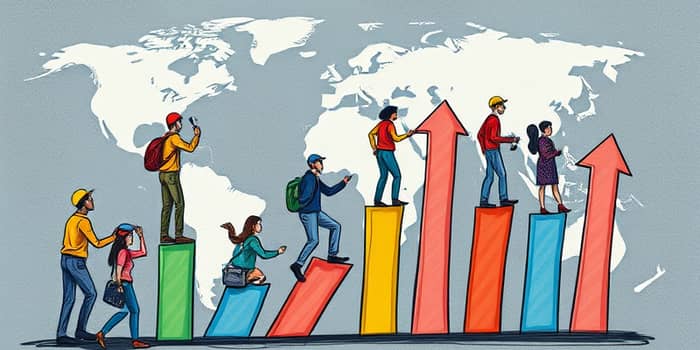
Unemployment, by definition, refers to individuals who are actively seeking new employment opportunities but unable to find work. This figure serves as a critical indicator of economic vitality, reflecting the balance between labor supply and demand. While many factors influence joblessness, from technological advances to policy decisions, the unemployment rate remains a benchmark for policymakers, investors, and citizens alike. Understanding these numbers is crucial to interpreting wider economic trends and planning for future resilience.
As economies around the world navigate post-pandemic recovery, the unemployment figure takes on heightened significance. It can signal economic distress or an overheating economy, guiding central banks, governments, and businesses in their strategic decisions. In recent years, global unemployment has gravitated around five percent, echoing pre-pandemic levels. Yet beneath this aggregate stability lie divergent stories of national performance, demographic challenges, and evolving economic pressures.
Against a backdrop of complex global dynamics, the overall unemployment rate has hovered near five percent for the past two years. This stability masks contrasting experiences across regions, industries, and demographic groups. In some areas, labor markets tightened as employers scrambled to fill open positions, while in others, joblessness lingered at elevated levels. The steadiness of aggregate numbers can obscure underlying shifts in workforce participation, underemployment, and labor force exit.
Recent data indicate that many advanced economies have seen modest job growth, but these gains have not uniformly translated into reduced unemployment rates. Factors such as skill mismatches, automation, and supply chain disruptions continue to shape labor market outcomes. Moreover, uneven progress in vaccination campaigns and lingering health concerns have left certain sectors more vulnerable, particularly those reliant on close physical interaction.
Within the Organisation for Economic Co-operation and Development (OECD), the unemployment rate settled at 4.9 percent in April 2025. This figure represents roughly 34.4 million individuals without work, a number that remained largely unchanged from the previous quarter. Of the 33 member countries reporting, 22 saw no significant shift in jobless rates, seven experienced declines, and four observed upticks. Such patterns underscore both the resilience and fragility of regional labor markets.
Among member states, Japan and Mexico boast the lowest unemployment rates, each at 2.5 percent. These countries benefit from robust manufacturing sectors, steady consumer demand, and favorable demographic trends. In contrast, Spain faces the highest unemployment level within the OECD at 10.9 percent, a legacy of structural challenges and high youth joblessness. The United States, with a rate of 4.2 percent, sits below the OECD average, reflecting a dynamic job market that added 139,000 positions in May 2025.
Youth unemployment remains a persistent concern, with rates for individuals aged 15 to 24 soaring above those for older cohorts. The OECD youth jobless rate stands at 11.2 percent, compared to 4.1 percent for adults aged 25 and over. Young people often grapple with limited formal work experience, skill mismatches, and the volatility of entry-level positions, leaving them disproportionately exposed during economic downturns.
Gender disparities also permeate labor markets, with women experiencing higher unemployment rates than men in numerous countries. This imbalance reflects a combination of caregiving responsibilities, sectoral segregation, and persistent wage gaps. In Mediterranean economies, the gender gap in joblessness is particularly pronounced, exacerbating social inequalities and underutilizing valuable talent pools.
Economists categorize unemployment into distinct types to better diagnose and address root causes. Differentiating among frictional, cyclical, structural, and institutional joblessness allows policymakers to tailor interventions and measure progress more effectively. Each category reflects unique labor market dynamics and requires specific strategies to mitigate its impact.
The interplay between economic growth and employment is complex. In 2024, the global economy expanded modestly, spurred by consumer spending and government stimulus. Employment figures improved accordingly, but growth was insufficient to eradicate lingering job deficits. Many regions still face an output gap, where actual production falls short of potential, limiting the absorption of available labor.
In the United States, the labor market demonstrated resilience, with 139,000 jobs added in May 2025. Hiring in service sectors, such as healthcare and hospitality, offset declines in manufacturing and construction. Yet, wage growth remained moderate, pointing to persistent underemployment pressures and challenges and tightening labor conditions. Investors and policymakers vigilantly monitor these indicators for signs of inflationary pressures or overheating.
Looking ahead, several headwinds threaten labor market stability. Rising costs from climate change adaptation, geopolitical tensions affecting trade, and technological disruptions are reshaping employment landscapes. Industries must navigate supply chain vulnerabilities, energy transition, and the integration of artificial intelligence, all while maintaining workforce resilience.
Global growth projections for 2025 remain positive but show signs of deceleration. International organizations forecast a slowdown in major economies, driven by tighter monetary policies, debt constraints, and uneven vaccination coverage in emerging markets. Under these conditions, reducing unemployment will require coordinated fiscal measures, targeted retraining programs, and inclusive labor policies that address structural barriers.
To bolster job creation and reduce unemployment, governments, businesses, and educational institutions must collaborate. Investment in vocational training, digital skills, and green technologies can equip workers for the jobs of tomorrow. Social safety nets and active labor market programs play crucial roles in supporting individuals during transitions and ensuring that no one is left behind.
Ultimately, understanding the nuances of unemployment figures empowers stakeholders to craft effective solutions. By examining the data, recognizing demographic disparities, and anticipating emerging challenges, societies can foster inclusive and sustainable job growth. As the global economy evolves, these efforts will be instrumental in shaping a future where employment opportunities are accessible, resilient, and equitable for all.
References













